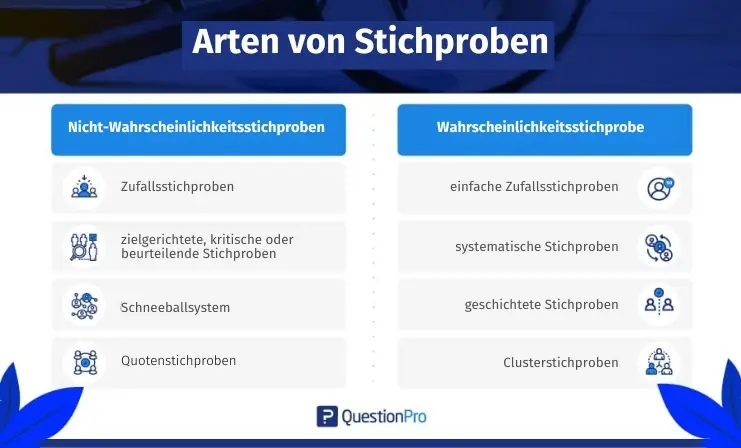Market research
When conducting research, it is almost never possible to study the entire population in which one is interested. For this reason, researchers use different types of samples when collecting data and answering research questions.
A sample is a subset of the population being studied. It represents the larger population and is used to draw conclusions from that population. It is a research technique widely used in the social sciences that can be used to collect information without having to cover the entire population.
In this article we will introduce you to the different ones Types of samples what they are, what they consist of and when it makes sense to use one or the other.
Classification of types of samples
There are two main sampling methods in research: probability-based and non-probability-based. Let's look at the different types of samples you can create using both techniques for efficient data collection for your next investigation.
Types of non-probability sampling
Non-probability sampling is a sampling technique in which samples are collected using a procedure in which not all people in the population have an equal chance of being selected.
While selecting some of these methods may result in biased data or a limited ability to draw general conclusions based on the results, there are also some situations where selecting these types of sampling methods may be the best option for a particular research question or a specific phase of research.
There are 4 types of samples you can create this way.
1. Random sample
Random sampling is a sampling method that relies on available people, such as: B. stopping people on the street corner as they walk past.
In this method, also known as the available-person method, the researcher has no control over the representativeness of the sample.
However, it is useful if the researcher e.g. B. want to study the characteristics of people passing on a street corner at a particular time, or when time and resources are so limited that the study would otherwise not be possible.
For this reason, random samples are one of the types of samples commonly used in the initial or pilot phase of research projects before starting a larger research project.
While this method can be useful, the researcher cannot generalize the results of a random sample to a larger population.
2. targeted, critical or judgmental samples
The purposive, critical or critical sample is a sample that is selected based on knowledge of the population or the purpose of the study.
For example, if sociologists want to study the long-term emotional and psychological effects of an abortion, they may create a sample that includes only women who have had an abortion.
In this case, researchers may use purposive sampling because respondents fit a specific description or purpose needed to conduct the research.
3. snowball sampling
Snowball sampling is appropriate when members of a population are difficult to locate, such as: B. Homeless people, migrant workers or undocumented immigrants.
In snowball sampling, the researcher collects data on the few members of the target population they can locate and then asks them to provide the information necessary to locate other members of the population they know.
For example, if a researcher wants to interview undocumented immigrants from Mexico, he or she might interview a few undocumented people that they know or can locate, and then rely on those people to locate additional undocumented people.
This process continues until the researcher has all the interviews he or she needs or until all contacts have been exhausted.
This technique is useful when investigating a sensitive topic that people do not want to talk about openly, or when speaking about the topics being investigated could jeopardize their safety. The recommendation of a friend or acquaintance who considers the researcher trustworthy helps to increase the sample size.
4. Quota sampling
Quota sampling involves selecting the units of a sample based on predetermined characteristics so that the overall sample has the same distribution of characteristics assumed in the population being studied.
For example, if you are a researcher conducting a national quota sample, you need to know what proportion of the population is male and what proportion is female.
It is also necessary to know what proportion of members of each gender belong to different age, racial or ethnic, educational and other categories. The researcher would then create a sample with the same proportions as the national population.
Types of probability factor sampling
Probability sampling is a technique in which samples are collected through a process that gives all people in the population an equal chance of being selected.
Many consider this to be the most methodologically rigorous approach to sampling because it eliminates social biases that could influence the research sample. Ultimately, however, you should choose the sampling technique that best answers your research question.
Now let's look at the 4 types of samples.
1. simple random sampling
Simple random sampling is the basic sampling method used in statistical methods and calculations.
When collecting a simple random sample, each unit of the target population is assigned a number. A series of random numbers is then generated and the units that have those numbers are included in the sample.
Suppose you have a population of 1.000 people and want to select a simple random sample of 50 people. First, each person is numbered from 1 to 1.000.
Then you create a list of 50 random numbers, usually using a computer program, and the people assigned those numbers are the people you want to include in the sample.
When studying individuals, this technique works best with a homogeneous population that does not differ greatly in age, race, education, or class, because a heterogeneous population risks sample bias if demographic differences occur not be taken into account.
2. systematic sampling
In systematic sampling, the elements of the population are put into a list and then every nth element of the list is systematically selected for inclusion in the sample.
For example, if the study population is 2.000 students in a high school and the researcher wants a sample of 100 students, the students are put on a list and then every XNUMXth student is selected for the sample.
To ensure that there is no human bias in this method, the researcher must randomly select the first person. Technically speaking, this is a systematic sample with a random start.
3. stratified sampling
Stratified sampling is a sampling technique in which the researcher divides the entire target population into different subgroups or strata and then randomly selects the final subjects proportionally from the different strata.
These types of samples are used when the researcher wants to highlight specific subgroups within a population.
For example, to obtain a stratified sample of university students, the researcher would first need to divide the population by year of study and then select the appropriate number of freshmen, sophomores, juniors, and seniors.
This ensures that the researcher has an appropriate number of subjects from each grade level in the final sample.
4. Cluster sampling
Cluster sampling can be used when it is impossible or impractical to create an exhaustive list of the elements that make up the target population. However, as a rule, the elements of the population are already grouped into subpopulations and lists of these subpopulations already exist or can be created.
For example, suppose the target population of a study were church members in Guatemala. There is no list of church members in this country.
However, the researcher could compile a list of churches in Guatemala, select a sample of churches, and then obtain lists of the members of those churches.
Conclusion
Anyone who has ever worked on a research project knows that resources are limited: time, money and people are never unlimited. That is why most projects aim to collect data from a sample of people rather than the entire population (the census is one of the few exceptions).
In any case, the type of sampling you choose allows for richer data collection than targeting all members of a population. Selecting participants who are appropriate for a project's purpose is critical because it allows researchers to collect high-quality data.
Now you know the types of samples that can help you with your next research project. If you would like more recommendations for selecting the best sample, methods and instruments, download our free Market research ebook .
Don't forget that QuestionPro Audience can also help you select the sample for your next project. Ask for more information about this sampling service in our online chat!
1:1 live online presentation:
QUESTIONPRO MARKET RESEARCH SOFTWARE
Arrange an individual appointment and discover our market research software.
Try software for market research and experience management now for 10 days free of charge!
Do you have any questions about the content of this blog? Simply contact us via contact form. We look forward to a dialogue with you! You too can test QuestionPro for 10 days free of charge and without risk in depth!
Test the agile market research and experience management platform for qualitative and quantitative data collection and data analysis from QuestionPro for 10 days free of charge
FURTHER KEYWORDS
SHARE THIS ARTICLE
KEYWORDS OF THIS BLOG POST
Types of samples | sample | species
FURTHER INFORMATION
- Research Synthesis: Understand your research results
- Synthetic data: what they are, types, methods and uses
- Research Process: Steps to conduct the research
- Synthetic data generation: techniques and perspective
- Digital behavioral data: what it is, its importance and risks
- Data filtering: what it is, benefits and examples
- Data Science and Artificial Intelligence: Which is Better?
- Big Data and Artificial Intelligence: How do they work together?




